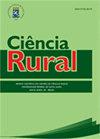Phenotypic and genotypic characterization of Brucella abortus biovar 4 isolates from cattle in Brazil
IF 0.9
4区 农林科学
Q3 AGRONOMY
引用次数: 1
Abstract
ABSTRACT: The aim of the present study was to characterize (phenotypically and genotypically) two strains of Brucella abortus identified as belonging to biovar 4 isolated from cattle in Brazil. The strains were isolated from cervical bursitis from cattle in the states of Pará and Rio Grande do Sul, respectively. In the phenotypic identification, the isolates were positive in CO2 requirement, produced H2S, were resistant to basic fuchsin (20 µg / mL) and sensitive to thionin (20 µg / mL and 40 µg / mL) and presented M surface antigen, but A surface antigen is absent. The isolates were positive in the PCR for the bcsp31 gene (genus-specific) and in the AMOS-enhanced PCR, both isolates showed a band profile consistent with B. abortus biovar 1, 2 or 4. Moreover, both isolates also showed restriction patterns identical to the reference strain when tested by the omp2b PCR-RFLP. In genotyping using Multiple Locus Variable Number of Tandem Repeat (VNTR) Analysis - MLVA (MLVA16), the isolates showed differences in several loci (Bruce42, Bruce19, Bruce04, Bruce16 and Bruce30); by Multiple Locus Sequence Typing (MLST), they also exhibited differences in sequence type (ST), strain 16/02 ST1 (2-1-1-2-1-3-1-1-1) and strain 128/11 ST (22-1-1 -8-9-3-1-1-1). The extensive typing of B. abortus strains isolated from cattle in Brazil using different approaches confirmed the occurrence of rare B. abortus biovar 4 in the country.巴西牛产布鲁氏菌4型分离株的表型和基因型分析
摘要:本研究的目的是对从巴西牛中分离出来的2株4型流产布鲁氏菌进行表型和基因表型分析。这两种菌株分别是从帕尔州和南大德州的牛颈滑囊炎中分离出来的。在表型鉴定中,分离株CO2需求量呈阳性,产生H2S,对碱性品红(20µg / mL)有抗性,对硫蛋白(20µg / mL和40µg / mL)敏感,存在M表面抗原,无A表面抗原。菌株的bcsp31基因(属特异性)PCR均为阳性,amos增强PCR结果显示,两株菌株的条带图谱均与abortus生物变种1、2或4一致。此外,通过comp2b PCR-RFLP检测,这两株分离株也显示出与参考菌株相同的限制性内切型。采用多位点可变数串联重复序列(VNTR)分析- MLVA (MLVA16)分型,分离株在多个位点(Bruce42、Bruce19、Bruce04、Bruce16和Bruce30)上存在差异;通过多位点序列分型(MLST)分析,菌株16/02 ST1(2-1-1-2-1-3-1-1)和菌株128/11 ST(22-1-1 -8-9-3-1-1)在序列类型(ST)上也存在差异。利用不同方法对从巴西牛中分离的abortus菌株进行了广泛分型,证实该国存在罕见的abortus生物变种4。
本文章由计算机程序翻译,如有差异,请以英文原文为准。
求助全文
约1分钟内获得全文
求助全文
来源期刊

Ciencia Rural
AGRONOMY-
CiteScore
1.70
自引率
0.00%
发文量
233
审稿时长
2-4 weeks
期刊介绍:
The purpose of Ciência Rural is to publish the results of original research, note and reviews which contribute significantly to knowledge in Agricultural Sciences. Preference will be given to original articles that develop news concepts or experimental approaches and are not merely repositories of scientific data. The decison of acceptance for publication lies with the Editors and is based on the recommendations of Editorial Comission, Area Committee and/ or ad hoc reviewers. The editors and reviewers are external to the institution.
 求助内容:
求助内容: 应助结果提醒方式:
应助结果提醒方式:


